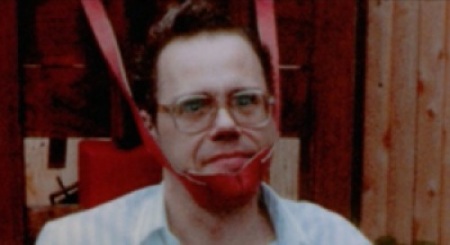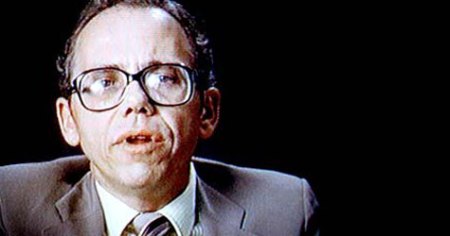15th March 2008
Ambulans
Janusz Morgenstern 1961
&
Mr. Death: The Rise and Fall of Fred A. Leuchter, Jr.
Errol Morris 1999

This morning I found myself thinking about the juxtaposition of the two films, and how interesting bleeds might occur between the two. I remember the really interesting double-bill during Documenta XII which put Cronenberg’s Existenz beside Brakhage’s The Act of Seeing with One’s Own Eyes – two films that, taken together in that way, really seemed to present an evening’s viewing as a body of interrelating, and exhausting, material. For me, they fed on each other in ways that allowed greater intensities and delicacies of imagery to emerge in both.
Anyway, I was thinking about some of the things Toni-Lynn has mentioned about her research and began considering the act of staring as it appeared in both these films. In Ambulans, there were a few lengthy shots of the children’s male guardian as he was looking intently at the SS guards preparing the ambulance – a gaze that was quite particularly blank, or even ‘open’ somehow (Incidentally, I’m sure there’s room for a consideration of just what constitutes a ‘stare’ and what a ‘look’, etc.). Even though it was in the midst of a sparse, theatrical setting – we commented about the use of the deserted airfield as a kind of endless non-space, a plateau which reminded me of the flattened sets in Dogville – the man’s gaze seemed somehow ‘undirected’, if you see what I mean. Of course it is absolutely directed, but it was as if the stare is supposed to be as neutral as possible – a look that gives nothing away, and perhaps then presents nothing for certain. A blank stare in relation to the unrepresentable…hmm, Rancière needs to be revisited again. For the stare to operate on this kind of blank sheet face, where there is no obvious reading to be discerned in his countenance, it is possible for it to be ‘filled’ or loaded with disgust, horror, pity, disbelief, even blankness or absolute nothingness, etc. By contrast, the various instances of Fred Leuchter’s ‘stare’, if I can call it that seemed very different. There were numerous moments in Morris’ film where Leuchter was photographed with, for me, a quite particular gaze. It not only appeared in the interviews and his reenactments demonstrating various execution mechanisms, but also in home movies and private photographs – images where he was perhaps shown strapping himself into electric chairs with a more tangible sense of macabre humour and gleeful self-consciousness about the eccentricity of his chosen profession – a self-fascination that he does well to disguise in much of the interviews, but which begins to emerge more and more clearly as the film becomes more complicated.
Of course, these private images were not ‘staged’ by Morris – they were not subject to the more manipulative camera angles and dramatic lighting effects that, elsewhere in the film, certainly did seem to portray Leuchter as a mad scientist figure (in his Tesla birdcage) or maniacal whackjob. These vaguely ridiculous sequences put together by Morris (and which Leuchter willingly inserted himself into) often seemed to capture and/or manipulate a kind of ‘stare’, and perhaps the considered capturing of a ‘look’ of this type relates to broader questions as to the way a filmmaker frames the subject of his work. In saying that, it seems to me though that the most ‘damning evidence’ – and by this I mean the instances where more or less serious manipulations, distortions and misjudgments (of action, appearance, responsibility, accountability, etc.) were revealed – was most obviously presented by the original footage of Leuchter’s visit to Auschwitz – in which Morris did not have a directorial hand beyond its placement in the wider context of his documentary. No doubt there is something about the physical appearance and bearing of both men that is worth thinking about. The guardian in Morgenstern’s film has an elegant, well-proportioned face, which in some ways is unremarkable to the degree that it is not noticed. Leuchter, on the other hand, is quite a strange-looking person. As Toni-Lynn pointed out, Morris found him a quite formidable interviewee, and his physicality, though hunched & unasuming (was it David irving who described him as a “mouse of a man”?), does suggest a tangle of conviction and self-regard that is unnerving. The thick lenses on his (oversize) glasses also seems to emphasise his eyes in a quite particular way, in some ways worsening the awkward gestures he seems to get photographed employing on occasion.

More generally I was fascinated by the way the film, particularly towards the end, presented Leuchter’s uncertain make-up of naivety and hubristic arrogance, mainly through allowing his haplessness to emerge slowly and, to my mind, undeniably. The completely absurd, cod-theatrical nonsense of his ‘investigation’ at Auschwitz was painful and compelling viewing. It’s rare that a sequence can be put together in such a way that it provokes anger and laughter, but the sequence of events snowballed into stupidity in a way that it became increasingly hard to fathom. There were countless details that demanded questions, even interrogations, of the unfolding events – questions that did not really emerge in the film at the ‘appropriate’ moments, if at all (for me, Leuchter was not held to account directly enough). For example the pathetic, parodic manner in which the ‘investigation party’ dressed, the way notebooks were falling out of pockets and the absurd fumbling with ‘baggies’ (some kind of emblem of forensic rigour… sheesh) with frozen hands, the ‘clean brick’, the child-like hammering, etc. Even the anecdote about the ‘noodle water’ soup served at the Auschwitz guesthouse where Leuchter stayed – a building that used to be the SS headquarters – seemed to speak volumes of the ludicrously casual, touristic approach of the whole thing (… and I don’t know why, but this anecdote reminded me of the joke with which Woody Allen begins Annie Hall, about ‘small portions’… something very wrong in that association). the effect was of small, seemingly inconsequential actions taking on immense proportions – errors of judgement writ large, as a small-world stupidity was let loose in the wider landscape of history and culture, amid the highest political and ethical stakes imaginable.
There were two other things that I wanted to mention. Firstly, I was thinking about was the way in which, about halfway through, the film seemed to transform into something quite unexpected – in a way not completely dissimilar to what Neil mentioned about Love Streams – where the reasonably straightforward, thought offbeat, story of the guy with the ‘unusual’ job, with his seemingly genuine concern for it to have some recognisable (& recognised) meaning and clarity of purpose, etc. etc. suddenly became an increasingly shocking story about being out of one’s depth in a massively enlarged arena of responsibility, yet failing to recognise that the shore was quickly disappearing from view. Secondly, and perhaps related to this, I wanted to bring up the heavy use of a black screen, which I noticed at the time but forgot to bring up. I don’t know if either of you two noted it, but it seemed that the film – the interviews especially – was continually being interrupted by these blackouts (though often the audio or image continued in a curious syncopation), almost as if the camera was blinking. Does this say something about Morris’, or our, increasing disbelief at what’s unfolding in front of our eyes? Or is it some other, more serious, syncope?
March 28, 2008 at 10:08 am |
David –
I did notice the camera’s ‘blinking’ during the interviews of Leuchter, and didn’t really know how to read it at the time. Given what you’ve said about the stare, this device does seem to anticipate the transformation of Leuchter’s harmless stupidity into his invidious denial of the holocaust.
That first still from the film (above) reminds me of the sense I got that there is something wrong with the way this man looks at the camera. The connection between his eye and his brain seems to be malfunctioning. (Would a post-mortem discover his optic nerve to have lesions?) Leuchtar’s look, so to speak, is profoundly fearful. It betrays his inability to read effectively the reactions of his interlocutors. Unable to respond appropriately, neither is he able to maintain the listener’s interest. As a result he has developed unconscious (half-conscious) strategies of manipulation. One is an attempted hypnotism. Morris’s editing might be a warning, that we should look away from the stare from time to time, otherwise get captured by it.
We were talking about “peripeteia” the other week when this term came up in Ranicère’s essay (’Are Some Things Unrepresentable?’). The curious quality that the narrative of Morris’s film has of turning itself from one thing into another – from profile of harmless eccentric to inquiry into the phenomenon of latent right-wing extremism – may be a good example. It’s interesting to consider what kind of affective quality the unexpected turn of events has in this work particularly. It might be one that operates by exposing the assumptions in viewing, exposing also the particular regime of the image (to use Ranicère’s term) which produces the viewer or instates a perspective on what’s being shown.
This is another respect in which the two films we watched make a good double-bill. Morgenster’s ‘Ambulans’ is a piece in which there is no sudden turn of events or reversal. Indeed, it is a film the narrative of which might be defined by its inevitability. When we talked about the film afterwards, I was trying to question this aspect of the form of the work, which it seemed tempting at the time to talk about in terms of coercion: the film condemns the murder of children, the viewer would not wish to (and would not be able to) take a different position. So to that extent, his/her capacity is curtailed, etc. However, I think it might be more interesting to consider the sweep of the films narrative not as over-determination in this way, but as something more like a strategic use of inevitability: because we are aware of the fate of the victims, and to the place this story is taking us – or to the extent that we are aware of these – we are compelled all the more forcefully to negotiate our our own understanding of the work in relation to what seem like marginal details. Resistance to the inevitable direction of a narrative comes in the form of an all-the-more vital search for diminishing counter-currents. Morgenstern provides these – for instance the sequences in which the child launches his toy helicopter and the dog, distracted from its guard duties, can’t resist the desire to play fetch with the prisoner.